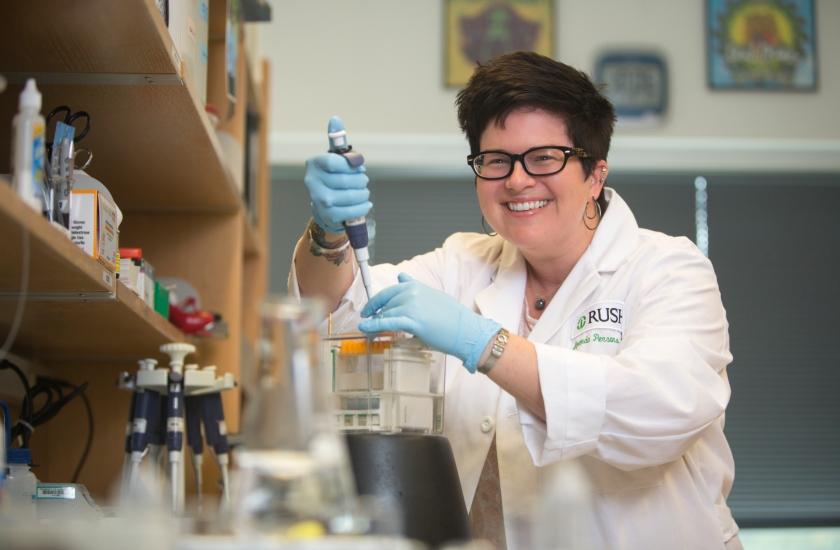Her research work has given Amanda Persons, PhD, deep knowledge of how drugs affect the brain. With appointments in three of Rush University’s four colleges, Persons takes insights she’s gained from her research into the classroom to better prepare future health care providers, particularly in how to treat substance misuse.
Persons' primary teaching role is as an associate professor in the Department of Physician Assistant Studies in the College of Health Sciences, where she is director of academic education and part of a faculty team that coordinates the first-year curriculum.
She also teaches pharmacology, and research and statistics, and she co-teaches a course on advanced neuroscience with Celeste Napier, PhD, for the Graduate College. In addition, Persons has an appointment in Rush Medical College’s Department of Psychiatry and Behavioral Sciences, where she conducts leading-edge neuroscience research in Napier's lab.
Early success in the lab
In 2017, Persons was among a select group of early career investigators at Rush to receive a fellowship from the Cohn Foundation to gather preliminary data that would serve as the foundation of an NIH-funded grant. Persons developed a plan to investigate whether rats with attention deficit hyperactivity disorder, or ADHD, that have been treated with stimulant drugs are more likely to develop Parkinson's disease, as a study has suggested. Her proposal is now under scientific review by the National Institutes of Health. Her inquiry could have important implications, since stimulants are a common therapy for ADHD in humans, including children.
"We really don't know the long-term consequences of exposure to stimulants during childhood and adolescence ," Persons says.
An education in curriculum development
As she continues her research, she also has taken on a role as an educator. "Research was my bread and butter, but I wanted to expand my options," says Persons, who came to Rush as a research postdoctoral fellow in 2009.
"I love teaching,” she says. “I love standing in front of a group of students and sharing the knowledge I have — helping to shape the future of medicine. It's something bigger than myself."
Persons helped develop curriculum for first-year physician assistant master's students around substance use disorder and its treatments with Regina Chen, PhD(c), MS, PA-C, assistant professor and chair of Physician Assistant Studies in the College of Health Sciences and director of Rush's Physician Assistant program; and Napier, a neuroscience researcher, Rush Medical College professor and director of Rush’s Center for Compulsive Behavior and Addiction.
"We're focused not only on doing the research but also on enhancing the education of our future health care providers," Persons says.
One important goal, not just at Rush but nationally, is to increase physician assistants’ understanding of substance use disorders, particularly opioid use disorders, from basic neurobiology to diagnosis, treatment and management. Building up the didactic and clinical curriculum is especially important in light of "the opioid crisis currently going on in the nation," Persons says.
Specialized lectures on neurobiology of addiction and addiction medicine are being incorporated into the first-year didactic curriculum. The second-year clinical curriculum has a required four-week behavioral health rotation, and a new advanced clinical practice behavioral health track was created for third-year students who want to specialize in behavioral health. The creation and implementation of this new track was spearheaded by Chen and the program’s director of clinical education, Jessica Vlaming, MS, PA-C.
Napier says Rush has been working to bring this knowledge to all its students. In the present phase, she says, the curriculum goal included "getting physician assistants well-qualified to treat substance use disorders in general, and opioid abuse and overdose prevention in particular." The curriculum never loses sight of the range of communities Rush serves; treating someone for opioid addiction who is socially or economically underserved, even homeless, is different from "how you might treat a patient who is economically secure with a great support system," Napier says. Proper training addresses how to provide this treatment without bias, she says.
Rush's physician assistant students are now required to complete 24 hours of training on medication-assisted treatment, or MAT. This training covers the basic pharmacology of MAT, diagnosis and treatment of opioid use disorder, practice guidelines, appropriate opioid prescribing, regulation of MAT and MAT in chronic pain. Completion of the training program qualifies them for an X-waiver from the federal government. The waiver allows them, as licensed clinicians, to prescribe buprenorphine, a drug that is one part of an effective treatment plan for opioid use disorder.
From local roots to the roots of Parkinson’s disease
Persons grew up in Chicago's southern suburbs, majored in biology and chemistry as an undergraduate at Lewis University in Romeoville, Illinois, and earned her doctorate in pharmacology from Loyola University Chicago. She joined Rush as a postdoctoral fellow in the lab of Jeffrey Kordower, PhD, who researches neurological diseases, including Parkinson’s disease.
"The search is on for some sort of marker we can use to see if someone is on the trajectory to Parkinson’s disease," Persons says. By the time symptoms of the disease are apparent, she explains, a massive number of neurons have been destroyed; reversing the condition is no longer possible.
"What treatment can we find to slow that, or stop it in its tracks?" Persons says.
More recently, she’s worked on projects in Napier's lab that explore new uses for drugs that have already won approval from the U.S. Food and Drug Administration for other conditions.
"Amanda is up on all the new drugs, and that's invaluable," Napier says. "We are taking up questions that are often siloed in terms of neurological disorders versus mental health. With Amanda’s skills playing a large role, we're bridging those gaps in knowledge through research in our laboratory."
Napier was Persons' dissertation adviser at Loyola, where Napier was a professor of pharmacology. The two have worked together for several years on a number of studies on topics such as the comorbidity of drug abuse and HIV/AIDS, the possibility that certain therapeutic drugs may decrease Parkinson’s disease patients' engagement in impulsive or risky behaviors like gambling, and the likelihood that people who abuse methamphetamine might be more likely to develop Parkinson’s disease over time.
"Amanda has really maintained her research credentials. She is a model researcher, and we need more like her," says Napier. "A few things have to be in place for the educator-researcher to be successful. Biomedical research at this level cannot be a hobby. It cannot be something you do on the side because it's fun. Research is an intensive investment of your time and energy. The second thing is that you have to be part of a team."
Collaboration with colleagues is one of Persons’ favorite parts of research. "I like sharing ideas and getting feedback from people, which can lead to totally new ways of looking at the research," she says.






